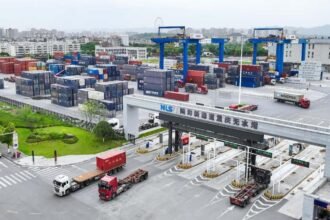PART 2
Abdul Wahid
China’s poverty alleviation relocation strategy has played a crucial role in lifting millions out of extreme poverty. This ambitious initiative involved moving people from inhospitable and disaster-prone areas—such as regions with harsh climates, fragile ecosystems, frequent natural disaster, remote mountains and deserts—to well-developed locations with proper housing, education, healthcare, and essential facilities and amenities to ensuring a higher standard of living.
China’s relocation policies and practices, particularly under its Targeted Poverty Alleviation (TPA) program, rank among the most ambitious and successful poverty eradication initiatives in the history are incomprehensible and unfathomable. The relocation program began in 1983, with 6.8 million (68 lakh) people relocated between 1983 and 2015. However, the most extensive phase occurred between 2016 and 2020, when 9.6 million (96 lakh) people were moved from remote, impoverished areas to regions with better economic opportunities, infrastructure and social services. This large-scale initiative became a cornerstone of China’s mission to eliminate extreme poverty by 2020. The Chinese government showcased strong commitment by meticulously planning relocation sites, new communities and sustainable economic development.
China has 34 provincial-level administrative regions, which include 23 provinces, 5 autonomous regions (Xinjiang, Tibet, Inner Mongolia, Ningxia & Guangxi), 4 municipalities (Beijing, Shanghai, Tianjin & Chongqing) and 2 Special Administrative Regions (SARs) (Hong Kong & Macau). During the 13th Five-Year Plan (2016–2020), as part of China’s extensive poverty alleviation campaign, 22 provinces, municipalities and regions were tasked with implementing targeted relocation policies. These efforts were particularly focused on western and central China, where large-scale relocation initiatives were carried out to move populations from impoverished and inhospitable areas to regions with better economic opportunities and living conditions. China’s relocation strategy was central to its poverty eradication efforts. Detailed surveys ensured targeted implementation, though many citizens were initially reluctant to leave their ancestral homes. To address concerns, the government prioritized voluntary participation, using incentives and awareness campaigns to build trust and encourage resettlement while respecting cultural ties. This approach aimed to build trust and motivate communities to willingly embrace the changes.
The most critical and central aspect of the initiative was to ensure the “Two Assurances and Three Guarantees” policy for 1.29 million people during their relocation, which formed a key pillar of China’s poverty alleviation efforts. The two assurances focused on meeting the basic needs of food and clothing, as well as ensuring stable and self-sufficient income for the relocated population. The three guarantees included providing access to compulsory education, basic medical services, and safe housing with a proper shelter system, ensuring their long-term well-being and stability.
Securing funds for the relocation program was a significant challenge for the government, as the initiative required RMB 60,000 per capita, totaling RMB 600 billion. To meet this financial demand, the National Development and Reform Commission provided substantial investment support within the central budget. Additionally, the Ministry of Finance, the People’s Bank of China, China Agricultural Development Bank, and China Development Bank reinforced financial backing through local government bonds, special funds, low-cost long-term loans, and other funding mechanisms. One of the biggest challenges was managing these extensive funds effectively. The government took proactive measures to empower local communities, ensuring that the allocated resources were utilized efficiently and directed toward the right projects, maximizing the impact of the relocation program.
This big scale relocation program which once seemed impossible became a reality as the Chinese government, with the strong support of its people, turned an unachievable dream into success. Driven by a deep sense of nationalism, this achievement was made possible through collective efforts, ensuring sustainable economic development by creating jobs, improving education and building modern infrastructure—an accomplishment difficult to replicate without such unity and national dedication.
Can Pakistan alleviate poverty through relocation?
Yes, Pakistan can indeed undertake relocation initiatives on a similar scale, taking inspiration from successful examples like the construction of New Balakot following the 2005 earthquake. New Balakot serves as a testament to Pakistan’s capacity to plan and execute relocation projects, offering safe housing and modern infrastructure for those impacted by natural disasters. However, to replicate such efforts on a larger scale, Pakistan must address several critical factors. Strong and efficient government commitment and planning are the most essential components, supported by clear policies and long-term strategies. One of the most significant challenges for the government is securing adequate funding for such initiatives. For instance, while the planning for New Balakot was a crucial step, the government faced difficulties due to insufficient funding, which hindered its ability to provide guarantees for basic education, housing, and other essential amenities to the affected population.
To overcome these challenges, Pakistan must involve local governments, communities, and institutions like the NDMA to ensure transparency and trust. Modern infrastructure and livelihood opportunities, including job creation, vocational training and business support for small medium enterprises (SME’s) are essential for the long-term success of relocation efforts, which are crucial for ensuring the economic stability and self-sufficiency of relocated communities.
By addressing these key areas, Pakistan can successfully implement large-scale relocation programs that improve living standards and promote sustainable development. (To be Continued….. )
The Author is a Senior Manager of Administration Pak China Investment Company Limited








